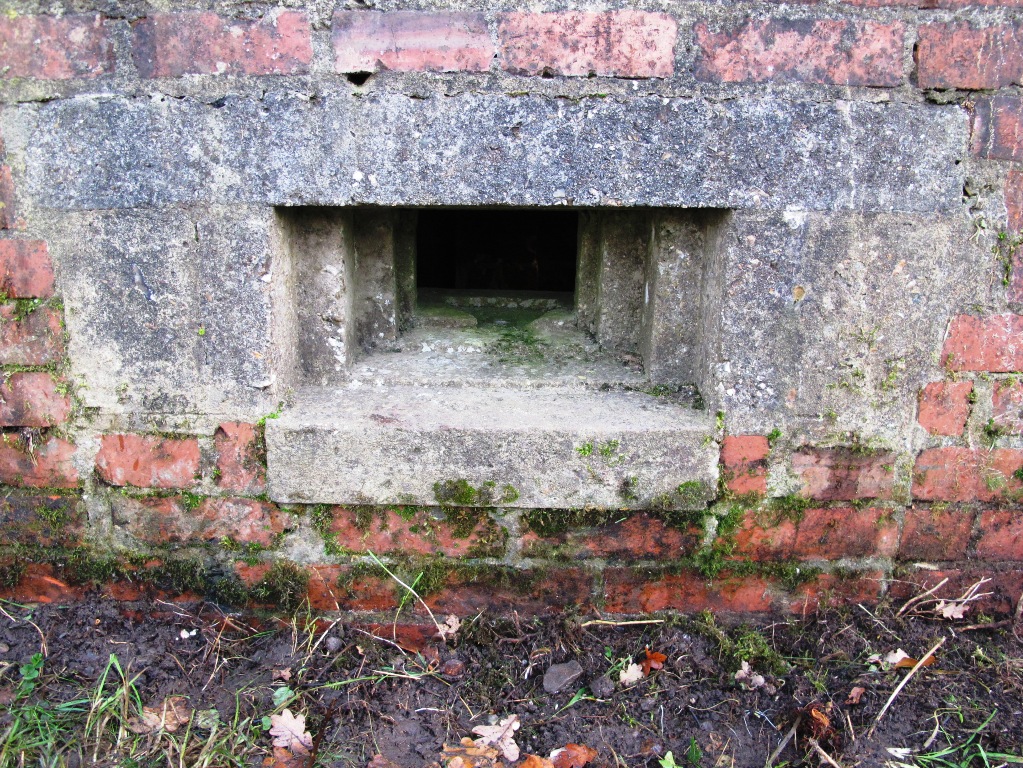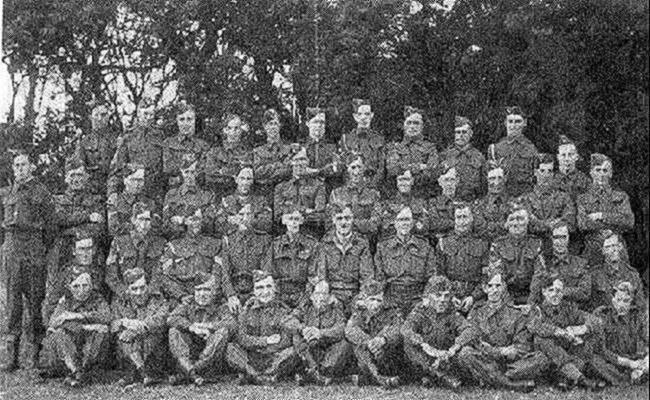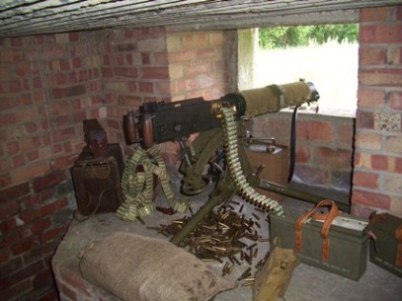A Vickers Emplacement 70 Years On
An early morning in July saw myself and Mike Hopton meet up to recreate how a fully equipped pillbox would have appeared seventy years ago. The purpose of the day was not only to see how it looked, but also to record the task step by step with photographs.
The Vickers machine gun box was one that had received attention during the autumn of 2009; we chose this particular pillbox as it survived intact and vandal free.
During late autumn of 2009 I dug and shovelled out the interior to the extent of having the concrete floor totally exposed and clean, during this excavation several spent .303in cases were found.
During further digging an intact flameproof flap from the side embrasure was uncovered buried in the doorway. Not long after completion of this work, the winters heavy rainfall and snow prevented access to the pillbox for many months leaving it flooded a foot deep.
During May the box had finally dried out, the inside of the defence was given a quick sweep and shovel out again ensured the pillbox was clean and ready for our work.
For the day Mike brought along his Vickers gun [de activated] as well as its associated equipment including ammo boxes, condenser cans and ammunition belts.
Mike had warned me that the tripod for the Vickers was heavy and difficult to carry; I soon found this out but still managed to carry it folded with one hand whilst carrying ammo boxes with the other!, carrying the gun over a shoulder was easier, this only weighed in at around 40 pounds. Once at the pillbox neither component was easy to manoeuvre between the blast wall and the tight side entrance.
I had brought along a folding wooden loophole table that was renovated some weeks before hand; this was attached by screws to a batten below the side embrasure shelf. The table enabled an effective display of the SMLE rifle [perched on a sandbag]; steel helmet and gas mask case, plus also a No36 Mills grenade and a .303in a charger, all of these were set in place for photographs.
Mike placed the Vickers tripod onto the concrete table, with all of the legs set at the same angle it enabled the tripod to sit straight and level before the gun was set into position.
With the tripod in place Mike lifted and steadied the gun on top while I slid the securing pins in place. The scenario before us was probably the only occasion it had been done in nearly 70 years, fitting perfectly [not that we expected any less] and in a strange way I think it gave us both a thrill to see it all work so well.

“THE BRITISH ARMY ON GIBRALTAR 1942” © IWM (GM 428) IWM Non Commercial Licence.
Next step was to fix the condenser hose to the front of the barrel jacket, to do this it was easier reaching from outside of the pillbox by leaning into the embrasure rather than stretch across the solid gun table. It was then discovered that the bottom lip of the loophole snagged the hose, so to allow for this the tripod rear leg was pulled back to around an inch from the tables back edge.
Pictures were taken with just the gun and tripod in place, Mike then started to dress the surrounding space, after we both filled a couple of sandbags with soil from outside of the box one was place over the rear leg of the tripod to make it assist in stabilisation.
The gun table was covered in associated equipment, a map case, MG Mk4 slide rule and several ammunition boxes. A full Belt of .303in rounds was attached to the gun and empty belts along with dozens of spent cases were spread around to make it appear that the gun was in “actionâ€.
To see the maximum elevation inside the pillbox Mike adjusted the Vickers elevating wheel, this gave the maximum possible for indirect fire and at the same time avoiding the top of the embrasure loophole.
Using the Vickers tangent rear site this showed a range of 2900 yards.
Using the same criteria, the lowest depression point possible allowed a strike of 15 yards directly in front of the pillbox, this was achieved with a measurement taken from the central axis of the tripod to the front wall of 21′, at this distance easy movement of the gun was possible from side to side as well as up and down, any further forward the condenser hose would have snagged on the embrasure.

Working in this confined space and on a warm day meant that several breaks were taken inside the pillbox for refreshment, we both sat there contemplating and looking at the assembled period equipment imagining just what would those guys have made of us who were here so long ago, it gave a great feeling of history.
The final stage of the day was to fit Mike’s genuine hessian WW2 cam or ‘scrim nets’. We had done the same exercise a few months in early spring, so with the summer months in full swing and the grass and undergrowth green it was going to appear different. Having two of these rare nets available we attached them to the front and side of the pillbox using the remaining hooks in the concrete, metal pickets pinned the outspread camouflaged material to the ground. The nets were inter twined using a small piece of stick and additional support was given by a larger piece of branch cut and used as a prop to hold the net taut.
Pleased with the results pictures were taken from several angles and at different distances showing how the outline of the defence was broken up. The Vickers pillboxes had a turf roof that really did prove effective concealment from aerial view and along with the nets it made a unique photographic record. The exercise had given us an insight on how it all pieced together and would have worked, it also gave us a hands on opportunity of what the gun crew would had to do in action in the restricted space of these cold and lonely gun emplacements.




